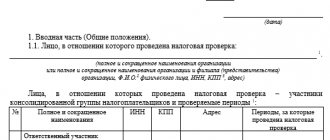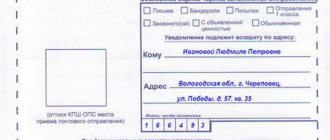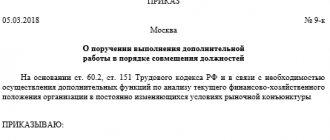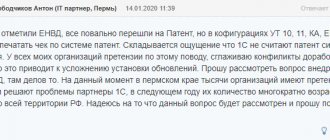The activities of any enterprise are impossible without the presence of official administrative documents. Usually these are orders for the enterprise.
They determine the procedure for fulfilling certain functional obligations and establish legal facts, such as employment, dismissal, promotion of ranks and categories. With the help of orders, regulations, instructions, rules and other organizational measures are approved.
Therefore, it is important to know what types of orders should be in the organization, how and by whom they are drawn up, where and how long they are stored.
THREE TYPES OF ORDERS
Our dictionary
An order is a legal act adopted by the head of an organization, acting alone, in order to regulate the activities of the organization[1].
Perhaps, of all the possible administrative documents of an organization, the order is used most often. Most of the manager's decisions are formalized by him.
Orders are divided into three types in only one regulatory document on office work - in the List of standard administrative archival documents generated in the process of activities of state bodies, local governments and organizations, indicating storage periods (approved by order of the Ministry of Culture of Russia dated August 25, 2010 No. 558, in as amended on February 16, 2016, hereinafter referred to as the 2010 List). We list the types of orders with storage periods (Table):
Table
Types of orders with storage periods according to the 2010 List
| Type of order | Shelf life | Note |
| By main (core) activity | Constantly | For organizations that are not sources of acquisition of state (municipal) archives, the period of storage of documents “Permanently” cannot be less than 10 years. This is indicated by a footnote to column 3 of the 2010 List |
| By personnel | 75 years if the order was created before 2003; 50 years if the order was created after January 1, 2003[2] | 5 years for orders: – about disciplinary sanctions; – annual paid holidays; – about leaves in connection with training; - about duty; – short-term domestic and foreign business trips |
| On administrative and economic issues |
It is not recommended to ignore the document storage periods established by the 2010 List. In accordance with the decision of the Supreme Arbitration Court of the Russian Federation dated February 21, 2012 No. 14589/11, they are mandatory for all organizations.
ORDER = ORDER?
Order – 1) a legal act issued individually by the head of a government body or organization in order to resolve operational issues;
2) the same as an order[3].
What “operational issues” are is not specified anywhere. In accordance with the 2010 List, the order is stored for the same periods as orders and is divided into the same types. In practice, in some organizations, the sole decisions of the director are formalized by instructions, rather than orders. This is acceptable.
Are these different orders, or are orders different from each other?
Workers, regardless of their place of work, often have to deal with orders. Sometimes such orders are necessary in official activities, sometimes they directly relate to the rights and responsibilities of themselves. What types of orders are there? From what date do orders of government agencies and other organizations come into force?
Orders and their types
The order itself is a type of administrative document. In addition, an order is a generic concept; it is common to several types of such documents.
The legislation contains several definitions of the concept “order”. They all differ from each other, since their definitions are set out in relation to the bodies authorized to issue (give) them. Another criterion, which also allows us to distinguish orders from each other, is the circle of persons to whom they apply. Some of them operate nationwide, others within one or more organizations, and some are completely one-time.
The most common document that employees have to deal with are orders issued by the organization where they work.
An order in organizations is understood as a legal act issued by the head of an organization, acting on the basis of unity of command, to solve the main tasks facing it <*>.
Orders issued in organizations are also divided into three types: by main activity; by personnel; on administrative and economic issues <*>. Depending on the type of order, the terms of its storage are established. At the same time, it is not allowed to combine issues of core activity and personnel in one order.
Orders in organizations can also be issued in other cases, for example, when it is necessary to bring the requirements of directive documents of higher organizations to the attention of subordinate persons and subordinate (part of the system) organizations, outline any specific measures for their implementation, determine responsible persons, deadlines for implementation these events.
Orders can also be adopted by republican government bodies (hereinafter referred to as government bodies). For example, such orders are issued by the Ministry of Labor and Social Protection, the Ministry of Construction and Architecture, the Ministry of Taxes, etc.
In this case, an order is understood as a normative legal act of a functional-sectoral nature, issued by the head of a government agency within the competence of this body in the relevant area of government <*>.
Example 1 Situation 1. Order of the Ministry of Labor and Social Protection dated December 28, 2017 N 194 “On establishing forms of checklists of questions (checklists).” Situation 2. Order of the Ministry of Construction and Architecture dated 02/09/2011 N 28 “On the regulatory method of pricing in the industry of building materials and structures of the Ministry of Architecture and Construction of the Republic of Belarus.” Situation 3. Order of the Ministry of Trade dated December 27, 2010 N 172 “On approval of standard time standards for sewing and cutting clothes according to individual orders of the population.”
There are several other definitions of orders. They fall within the scope of activities of the armed forces and equivalent bodies, customs authorities, financial investigation bodies, etc.
Note: In the military, an order is understood as a mandatory oral or written command from a superior, expressed in strict accordance with the law <*>. There are three transmission methods for this type of order. Such an order may be given in writing, orally, or via technical means of communication. A written order is the main administrative document (legal act) of military command, which is issued on the basis of unity of command. Oral orders are given by all commanders (chiefs). For customs officers and DFR employees, accordingly, an order is understood as a written or oral order from a superior, given within the limits of his authority, mandatory for execution by subordinates <*>.
Depending on the order of execution and issuance of orders, they can be divided into 2 large groups: written and oral .
Orders from government agencies and organizations of all types must always be in writing . This conclusion follows from the definition of the concepts of orders established for them in the legislation. At the same time, the legislation on civil service does not contain the concept of “oral order” at all <*>. However, relations related to the public service that are not regulated by Law N 204-Z and other acts are subject to the provisions of labor legislation <*>. And in labor relations, the employee is obliged to carry out not only written, but also oral orders of the employer, which do not contradict the legislation and local regulations <*>.
All orders can also be divided into two large groups: normative and non-normative .
If an order is adopted for the purpose of implementing specific (one-time) organizational, control or administrative measures or is designed for another one-time use, then it is non-normative <*>.
If orders of government agencies, as well as orders of organizations, apply to an indefinite number of persons (in the first case on a national scale, in the second case they apply on the scale of one or several organizations), then such orders will be normative .
Example 2 An order establishing a general procedure for bonus payments to employees of a commercial organization is a local regulatory legal act <*>, and orders for hiring, dismissal, transfer and relocation are non-regulatory legal acts <*>.
In addition, we can conclude that regulatory orders, regardless of the bodies (organizations) that adopted them, must always be written, and non-regulatory orders designed for one-time use can be oral.
Note: If non-normative order relates to personnel documents, such orders must also always be written <*>. They are usually stored for 75 years <*>.
When do the orders take effect?
It is not by chance that we gave a brief description of the orders, because depending on what type of order this or that order belongs to, what body (organization) it was adopted and to what circle of persons it applies, the rules for their entry into force depend.
The general rule for the entry into force of orders is as follows. If the effective date is indicated in the order itself, then it is valid from the date specified in it. The entry into force of regulatory orders adopted by government agencies is determined according to the Rules established in legislation <*>.
If regulatory orders do not set a deadline, they come into force from the day they are included in the National Register of Legal Acts of the Republic of Belarus (hereinafter referred to as NRLA) <*>.
At the same time regulatory orders concerning the rights, freedoms and obligations of individuals come into force only after their official publication .
Regulatory orders concerning the rights, freedoms and obligations of organizations and individual entrepreneurs come into force after their official publication <*>. This definition itself contains a clue. If an order of a government agency is published on the official website https://pravo.by/ in section 8, which has the title “Regulatory legal acts of the National Bank, the National Academy of Sciences of Belarus, ministries, and other republican government bodies,” then, accordingly, such an order is normative. At the same time, regulatory orders are published after their inclusion in the NRPA.
Example 3 Order of the Ministry of Labor and Social Protection dated November 30, 2017 N 152 was registered in the NRPA on January 19, 2018 under N 8/32743. Published on the website https://pravo.by/ 02/07/2018. The date of entry into force is not indicated in it, but it contains responsibilities for the preparation and presentation of departmental labor reports for an indefinite number of employers. Therefore, it comes into force after official publication, i.e. from 02/08/2018.
In other words, a regulatory order of a government agency may come into force on the date: - which is specified in the regulatory order; — inclusion in the NRPA, if it does not indicate the date of entry into force; - following the day of official publication, if such an order concerns the rights and obligations of citizens, organizations and individual entrepreneurs and the effective date is not indicated in it.
Other rules for the entry into force of regulatory orders may be provided for by legislative acts of the Republic of Belarus <*>.
Regarding orders issued in organizations: they can also be both normative and non-normative . However, the rules for the entry into force of such orders are simpler. There are only two of them. Unless a different period is specified in the order, it comes into force from the moment of its publication (acceptance) <*>.
Example 4 Situation 1. An order establishing a general procedure for bonuses for employees of a commercial organization was signed on December 28, 2022, but contained the wording that its provisions come into force on January 1, 2022. This order is regulatory, accordingly, if a bonus is paid to employees of the organization for 2022, the norms of this order should not apply to employees. Situation 2 . The order to dismiss the employee on December 29, 2022 was signed the day before December 28, 2022. Came into force on December 28, 2017. Accordingly, certain actions must be taken within the time limits specified therein. In other words, no later than December 29, 2022, the final payment must be made to the employee, a work book must be issued, etc.
ORDER DETAILS
In accordance with GOST R 6.30-2003 “Unified documentation systems. Unified system of organizational and administrative documentation. Requirements for the preparation of documents,” regardless of the type, the order must contain a set of mandatory details.
A note about familiarization with the document is not a requisite according to GOST, but is required to be formalized in orders for personnel. The employee signs in the field provided for this purpose:
Or make a mark by hand:
The latter design option is more common since it is considered proof of familiarization.
If the organization operates an electronic document management system, employees are not familiarized with orders for core activities and AHD upon signature.
Acceptance of a task automatically means familiarization with it.
As for the design and structure of the text, there are differences depending on the type of order being created.
Rules for drawing up orders: step-by-step instructions
In order to understand the rules for drawing up administrative documents, let’s consider an order for the main activity - a sample decree approving the staffing table.
All PODs are compiled using an identical algorithm and have a similar structure.
Let's consider step by step how to draw up an order for the main types of activities in accordance with the new GOST:
- The document must be drawn up on the organization's letterhead. At the top you must indicate the full (short) name of the institution, as well as its emblem and trademark (if any).
- Below is the name of the type of document - order, place of preparation (publication) (city or other locality) and its details (registration number, date). The numbering of orders for core activities is continuous, that is, each decree is assigned a serial number. Numbering starts from the beginning of the new year and ends with the last working day of the reporting period.
- The title is set - the topic of the administrative documentation.
- Preamble - text that precedes the instructions of the management. It is necessary to determine the reason for issuing the document, as well as the standard to which the manager refers. You need to end the introductory part with the word “I ORDER” (always in capital letters).
- Next, the instructions are listed, the deadlines for their implementation, the responsible persons and the person monitoring the progress of the execution of the orders are appointed.
- After listing all paragraphs, the instructions are signed by the manager or other authorized person according to the following scheme: position - signature - transcript of the signature. If available, a stamp is placed.
- The document ends with a section where all the persons indicated in the text sign. The signature confirms that the employee is familiar with the edition of the decree. The employee responsible for the development of this document must also sign.
If the decree requires additional information to be secured, annexes are drawn up that are an integral part of the AML. Their presence is stated in the text of the decree, and the annexes themselves are numbered in order and also signed by the head.
In accordance with GOST R 7.0.97-2016, if the administrative document is drawn up on two or more pages, then the second and subsequent pages must be numbered. The page number must be indicated in the middle of the top margin of the document, maintaining a distance of at least 10 mm from the top edge of the sheet.
The new standard allows you to draw up an administrative document on the front and back sides of the sheet. In this case, the width of the left margin on the front side of the sheet and the right margin on the reverse side should be the same.
ORDERS ON MAIN ACTIVITIES
Orders on core activities are designed to regulate the main activities of the organization. Their storage period is “permanent” or at least 10 years for organizations that are not sources of acquisition of state archives.
It is impossible to list the types of orders for core activities: it depends on the scope of the organization’s activities. However, we can distinguish categories of orders that are found in, perhaps, every organization. Let's list the categories and give examples of order headings.
•Approval, implementation, amendment of local regulations:
– “On approval of the Instructions for office work”;
– “On approval of the Nomenclature of Cases for 2022”;
– “On Amendments to the Internal Labor Regulations.”
•Creation, reorganization, liquidation and regulation of the activities of structural, separate divisions of the organization:
– “On the creation of the Office”;
– “On the liquidation of the “Western” and “Southern” branches and the creation of the “South-West” macro-region”;
– “On approval of the Archive Regulations.”
•Carrying out activities to resolve production issues:
– “On conducting an audit of office work”;
– “On conducting an examination of the value of documents”;
– “On approval of the Schedule for the acceptance and transfer of documents to the archive.”
•Resolution of operational issues related to the activity profile of structural divisions:
– “On the celebration of Labor Safety Day”;
– “On the development of an advertising campaign for a series of cosmetics “Morning in Scandinavia””;
- “On access of vehicles to the warehouse.”
And of course, the order on the main activity does not contain the distinctive features of orders on personnel and on administrative and economic issues, which we will discuss further.
Order classifier
Order classifier structure
The order classifier is a systematic collection of generalizations of information that determines how individual types of orders are formed, signed, named, registered, how many and where they are stored. Having become familiar with the classifier, any employee of the company will be able to accurately determine by name and number in the future which division a specific administrative act belongs to, where it was registered, and also who stores the original document.
Typically, an order classifier contains several main categories:
- Document type. This includes the main category (by personnel, main activities, administrative and economic), as well as subcategories (if necessary, divide existing administrative acts).
- Index. Placed after the order number so that you can quickly determine what this document is about.
- Who performs the registration and storage of the document. A position is required if orders are stored and recorded in different locations.
- Shelf life.
- A brief description of the direction that governs the order assigned to this category (subcategory).
- Signature right. The position is introduced if the enterprise has delegation of authority between the first manager and his deputies (heads of structural units).
Remember, having a general classifier of orders, you can quickly train employees to navigate the administrative documents available at the enterprise and ensure normal office work.
ORDERS ON ADMINISTRATIVE AND ECONOMIC ACTIVITIES
- What is AHV? It is difficult to say what is included in the range of “administrative and economic issues”. The 2010 List comes to the rescue again, namely section 10 “Administrative and economic issues”, which consists of subsections:
•compliance with internal business rules;
•operation of buildings and premises;
•transport services, internal communications;
•ensuring the security of the organization.
Thus, orders of the organization devoted to the above issues will be considered orders under AHD with a shelf life of 5 years. Apart from the 2010 List, there is nothing to be guided by: there is no other normative or methodological document on office work that would contain a list of administrative and economic issues.
If orders on personnel are quite easy to separate from the rest, then with orders on administrative and economic issues difficulties often arise. Many secretaries solve the problem radically: they simply do not separate these orders into separate proceedings and classify everything that is not related to personnel as their main activity. This approach, at least, eliminates error and untimely destruction of an order for the main activity that is incorrectly assigned to ACD. If there are not many orders in the organization and it is decided to store them for only 10 years (because the organization is not the source of the state archive), then this method has a right to exist.
Judging by the list of administrative and economic issues given in section 10 of the 2010 List, there are many situations in which an order on AHD is issued. So, orders on AHD can be:
•order on the admission of workers/equipment to the organization’s facilities (Example 3);
•on determining a smoking area;
•on the transition to an electronic access system;
•repair of premises;
•on organizing the purchase of furniture, office equipment, household goods, office supplies;
•organizing the transportation of furniture, office equipment, documents when moving;
•organization of cleaning services (comprehensive or one-time);
•on assigning vehicles to drivers and officials;
•allocation of vehicles to solve various problems;
•allocation of corporate telephone numbers to employees, setting a call limit;
•conducting briefings on civil defense and emergency situations;
•on the protection of objects, etc.
It is impossible to provide an exhaustive list, as is the case with orders for personnel.
- AHD or not? Let's use a cheat sheet. Example 3 shows a common situation:
Let’s “run” this order according to four mandatory criteria (see sidebar “How to determine an order using AHD: cheat sheet”):
1) relates to the administrative and economic issue “Compliance with internal business rules” (section 10.1 of the 2010 List);
2) does not approve or make changes to the organization’s LNA;
3) does not contain solutions for personnel management. Yes, it lists the employees who will come during non-working hours, but going to work on Saturday was issued by a separate order for personnel, indicating remuneration and each person’s personally written consent. Our order simply lists the names of employees who must pass through the checkpoint. Under what conditions they do this is not the concern of the head of the security service;
4) does not contain personal data. Position and full name security chiefs are present in the text of the order for the sole purpose of indicating the employee to whom the task is entrusted.
Thus, the order relates to ASD (ensuring the security of the organization) and is one-time. “Constantly”[6], and especially for 50 years in the archive, he has nothing to do.
Basic list of labor protection documents
So, the main list of documents on labor protection.
Orders
- on the appointment of responsible persons for safe work performance, control of working conditions, fire safety, electrical safety, and for instruction (induction, at the workplace);
- on approval of documents;
- on the creation of a knowledge testing commission.
Specifically, if we are talking about orders, these are orders on the appointment of persons for the safe performance of work, for monitoring working conditions, fire safety, electrical safety - responsible persons must be appointed for all these activities. Order “On approval of documents”, i.e. your position, your instructions, they must be approved by order of the manager.
Questions regarding employee training. Start by creating your own commission to test knowledge of labor protection and conduct timely briefings.
What should we do if, for example, it is impossible to create a commission to test knowledge of labor protection due to the fact that the organization is small - 3-4 people. You have two options, either go to a training center to train everyone, ask for a discount, and they, accordingly, let them train you all and for 3 years this will be enough for you, or somehow form your own commission, again of three people, and train these two or one person by its commission.
Instructions
- first aid instructions;
- instructions for the safe movement of workers;
- instructions for professions;
- instructions for types of work;
- instructions for personnel of group 1 on electrical safety.
All instructions on labor protection . The slide shows the most basic ones. This includes first aid, safe movement of workers, professions, types of work, and instructions for personnel of group I on electrical safety. We develop the remaining instructions by type of work and profession.
We do not consider instructions for visitors, and especially for students and pupils, to be part of labor protection. For students and pupils, there is a separate section of documents - child safety. If these are trainees, then it is still possible, but if these are students, then, accordingly, these will already be some kind of safety rules or instructions for safe behavior.
Provisions
- on the occupational safety management system;
- regulations on the organization of training and testing of knowledge on labor protection;
- Regulations on the Occupational Safety and Health Commissioner.
Regulations on the labor protection management system , regulations on the organization of training and testing of knowledge on labor protection and regulations on the authorized representative for labor protection from the workforce. In fact, you can have as many regulations as you like; the main document is the regulation on the occupational safety management system. Regarding the presence of other provisions, you look at the situation that you have, whether you need to regulate the processes in a separate document or not. You can spell out everything in one regulation - about the labor protection management system, and that’s it, and this will close the whole issue regarding the regulations. But we, for example, make enough of these provisions in our kits so that questions do not arise. If anyone wants to do this, please do it.
Programs
- induction program;
- on-the-job training program;
- internship programs;
- training programs and tickets for blue-collar professions;
- training programs and tickets for managers and specialists.
Programs – this means training and testing programs for labor protection and instruction. There must be an induction program and with it there must be instructions for conducting the instruction. This can be a single document or two separate documents. Usually everything goes in a single document, i.e. the program for several sheets and then the material itself, instructions.
On-the-job training program: accordingly, we can include specific questions on the instructions, i.e. what instructions the employee should be familiar with, as well as questions for conducting training.
Protocols
- protocols for testing knowledge on labor protection;
- PPE replacement protocols (if required);
- protocols for selecting a labor protection representative from the workforce;
Protocols for testing knowledge on labor protection. They cannot exist without tickets and training programs.
If any protocols are required for replacing personal protective equipment, we remember that we can replace some PPE with others if they do not degrade their protective properties.
As well as protocols for the selection of a labor protection representative from the workforce. The labor protection representative of the workforce, or the chairman of the trade union, approves documents on labor protection. And if you choose an authorized person, then, accordingly, there should also be some kind of protocol in free form.
Magazines
- logs of introductory briefing on labor protection;
- workplace briefing log.
You can add a lot of things here, but this is the very minimum that any organization should have.
Rules, normative documents
- set of regulatory documents.
Rules, various regulatory and technical documentation - this is a set of state regulations that you have. Either they are stored in Word format on your computer, or printed, someone buys books with these collections of these documents. But I don’t see the point in buying books just with laws. Now everything is on the computer, you can read it, look at it and even copy links from there, i.e. all this is convenient. But for some reason, in stores I still see these books with labor safety rules being sold. Why are they needed if you have a computer?
Lists
- list of personal protective equipment;
- list of cleaning agents;
- list of employees exempt from training;
- list of labor protection instructions;
- a list of persons applying for work who are subject to preliminary examinations;
- list of employees subject to periodic inspections;
- name list of employees subject to periodic inspections.
Lists – lists of special clothing, i.e. personal protective equipment, a list of flushing agents, a list of those exempt from instructions, a list of occupational safety instructions, a list of persons for medical examinations. And by the way, I did not take into account one list here - this is the list of personnel who are assigned Group I in electrical safety.
Account cards
- registration cards for the issuance of personal protective equipment;
- cards for issuing detergents.
Made according to changes from 03/01/2022
FEATURES OF DESIGN OF TEXTS OF ORDERS
- The text of the order consists of two parts. The text of the order, unless the document is drawn up according to the form approved by the State Statistics Committee, always has a clear structure. It is divided into two parts: ascertaining and administrative. The parts are separated from each other by the word “I ORDER” (see Examples 2 and 3).
- Management decisions in the order are numbered. If the decisions are drawn up as a bulleted list, then it will be impossible to refer to any of the points of the administrative document in this case. There are simply no points. There are dots, check marks, or other symbols, depending on what the secretary likes. And it’s quite difficult to refer to the point. For comparison, here are two options for designing the administrative part of the order text:
- The text of the order is presented in the first person. Secretaries are often embarrassed by the need to formulate the management decision of the manager in the first person and use phrases such as: “I ORDER”, “prepare a project and submit it to me for approval”, “I leave control to myself”, etc. However, this is exactly how an administrative document issued under conditions of unity of command should be drawn up. Despite the fact that the author of the text of the order is almost always an ordinary employee of the organization, the document is issued on behalf of the manager, hence the grammatical form of the first person singular.
Separate list of documents on occupational safety
In addition to the main list of documents, we have a number of other questions that affect other processes. These are, for example, a special assessment of working conditions, assessment of professional risks and fire safety.
South
- report on the conduct of SOUT (special assessment of working conditions);
- declaration of conformity of working conditions.
For a special assessment of working conditions, it is necessary to have a report on the conduct of the special labor assessment. Also, do not forget about the declaration of conformity with working conditions, that you must send it after the approval of the report on the implementation of the special labor assessment. You must familiarize all employees with the results of a special assessment of working conditions, and you must also monitor new jobs in your organization, this is also important. After all, according to the law, 12 months are allotted from the date of organization of a new workplace for carrying out an unscheduled SOUT.
Assessment of professional risks.
There must be a whole package of documents, the same as for a special assessment of working conditions.
- list (register) of hazards;
- a document (section of the Regulations on the employer’s SAW) describing the method(s) used for assessing the level of risk;
- a document confirming the assessment of risk levels, indicating the established levels for each risk (risk assessment cards - author's note);
- a document containing a list of measures to eliminate, reduce or control risk levels;
It is important to note that district administrations are now requesting information on the number of workplaces where occupational risks were assessed in 2018-2020.
ODA
- list (register) of hazards;
- methodology for assessing the level of risk;
- risk assessment cards;
- a list of measures to eliminate, reduce or control risk levels.
Fire safety
- documents reflecting organizational measures to ensure fire safety;
- operation log of fire protection systems with attachments;
- instructions to eliminate violations of fire safety requirements of the supervisory authorities of the Ministry of Emergency Situations of Russia or inspection reports in the absence of violations of fire safety requirements.
Regarding fire safety, the blocks of documents that need to be prepared are:
- documents reflecting organizational measures to ensure fire safety, i.e. these are various orders, instructions, etc.;
- the main log of fire protection systems with attachments of relevant documents;
- and instructions to eliminate violations of fire safety requirements, i.e. or some acts or orders stating that you have no violations.
Made according to changes dated March 1, 2022.
All of the above documents that I indicated here are in our document directories. We have collected all our developments in one package of documents and this is an excellent solution for problems with preparing documentation for your institution or organization.





